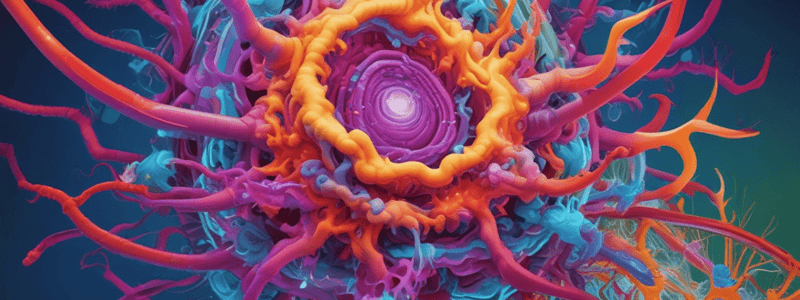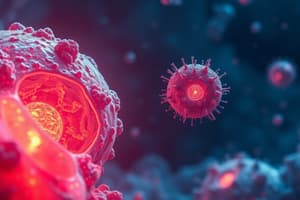Podcast
Questions and Answers
Who proposed the theory of epigenesis?
Who proposed the theory of epigenesis?
- Karl Ernst von Baer
- Aristotle (correct)
- Nicolaas Hartsoeker
- William Harvey
What process produces haploid male and female germ cells?
What process produces haploid male and female germ cells?
- Fertilization
- Oogenesis
- Gametogenesis (correct)
- Spermatogenesis
Which scientist proved the theory of epigenesis with the discovery of the mammalian ovum?
Which scientist proved the theory of epigenesis with the discovery of the mammalian ovum?
- Karl Ernst von Baer (correct)
- Aristotle
- Nicolaas Hartsoeker
- William Harvey
What is the process of formation of sperm cells called?
What is the process of formation of sperm cells called?
What is the term for the merging of male and female germ cells?
What is the term for the merging of male and female germ cells?
What is the term for the new structure formed by the combination of male and female cells?
What is the term for the new structure formed by the combination of male and female cells?
What is the term used to describe the embryo after 3 months of development?
What is the term used to describe the embryo after 3 months of development?
Which of the following is not a part of the conceptus?
Which of the following is not a part of the conceptus?
What is the term used to describe the period after birth?
What is the term used to describe the period after birth?
What is the term used to describe the period between 12-15 years of age?
What is the term used to describe the period between 12-15 years of age?
What is the term used to describe the process of formation and development of specialized generative cells, gametes?
What is the term used to describe the process of formation and development of specialized generative cells, gametes?
What is the chromosome number of gametes after meiosis?
What is the chromosome number of gametes after meiosis?
What is the main function of the acrosome in a sperm cell?
What is the main function of the acrosome in a sperm cell?
During which phase of spermiogenesis is the unneeded cytoplasm shed from each spermatozoon?
During which phase of spermiogenesis is the unneeded cytoplasm shed from each spermatozoon?
Which of the following is not a function of the female reproductive system?
Which of the following is not a function of the female reproductive system?
How do females and males differ in their ability to produce gametes?
How do females and males differ in their ability to produce gametes?
What is the main function of the mitochondria in the midpiece of a sperm cell?
What is the main function of the mitochondria in the midpiece of a sperm cell?
What is the purpose of the uterine tubes in the female reproductive system?
What is the purpose of the uterine tubes in the female reproductive system?
What is the fluid-filled cavity known as?
What is the fluid-filled cavity known as?
Which layer surrounds the cavity in the blastocyst?
Which layer surrounds the cavity in the blastocyst?
When does implantation begin?
When does implantation begin?
What is the primary function of syncytiotrophoblast?
What is the primary function of syncytiotrophoblast?
At what stage does the embryo enter the blastocyst stage of development?
At what stage does the embryo enter the blastocyst stage of development?
During diagnostic amniocentesis, what is the purpose of taking up amniotic fluid?
During diagnostic amniocentesis, what is the purpose of taking up amniotic fluid?
During which phase of the ovarian cycle does the release of the oocyte from the mature follicle occur?
During which phase of the ovarian cycle does the release of the oocyte from the mature follicle occur?
What hormone is responsible for the initial growth of primordial follicles in the ovary?
What hormone is responsible for the initial growth of primordial follicles in the ovary?
What happens to the secondary oocyte if it is not fertilized?
What happens to the secondary oocyte if it is not fertilized?
Which structure is formed in the ovary after ovulation and plays a role in producing progesterone?
Which structure is formed in the ovary after ovulation and plays a role in producing progesterone?
Which two hormones control the monthly changes in the ovary and uterus during a woman's reproductive life?
Which two hormones control the monthly changes in the ovary and uterus during a woman's reproductive life?
What is the fate of a primordial follicle that begins a process of follicular growth?
What is the fate of a primordial follicle that begins a process of follicular growth?
Flashcards are hidden until you start studying
Study Notes
Preformationism Theory
- Nicolaas Hartsoeker's 1656 sketch of the homunculus, a tiny preformed human believed to exist in the head of spermatozoa
Epigenesis
- William Harvey's accepted theory of development from a seed or egg in a sequence of steps
- Originally proposed by Aristotle 2,000 years earlier
- Modern embryology developed from Karl Ernst von Baer's work, who proved epigenesis with his discovery of the mammalian ovum (egg) in 1827
Terminology in Embryology
- Gametogenesis: Production and development of haploid male and female germ cells
- Spermatogenesis: Process of formation of sperms (testes)
- Oogenesis: Process of formation of ovum (ovary)
- Coitus: Sexual intercourse
- Fertilization: Merging of male and female germ cells
- Zygote: New structure formed by combination of male and female cells
- Blastocyst: Hollow structure in 1st and 2nd weeks
- Gastrula: 3-layer (trilaminar disc) disc formation in 3-week embryo
- Embryo: Embryo in the first 3 months
- Fetus: Embryo after 3 months
- Conceptus: Fetus with all additional membranes (vitellus amnion-umblical cord-chorion)
Terminology in Embryology-2
- Abortion: Birth before 20 weeks (a- spontaneous, b- therapeutic)
- Trimester: Clinically divided 9 months of pregnancy into 3 months
- Organogenesis: Differentiation of organs
- Prenatal Period: Period before birth
- Postnatal Period: Period after birth
- Newborn: First 4 weeks after birth
- Infantile (infancy): Period from birth to the end of first year
- Childhood: Period between 2 to 12 years
- Puberty: Period between 12-15 years
- Adolescence: 3-4 years after puberty
- Adulthood: Period between 20-60 years
- Senility: Period after 60 years and older
Gametogenesis
- Process of formation and development of specialized generative cells, gametes
- Involves reduction of chromosome number by half during meiosis
- Gamete maturation called spermatogenesis in males and oogenesis in females
- Acrosome: Specialized type of lysosome containing hydrolytic enzymes
- Sperm Morphology: Adapted for reaching and fertilizing the egg
Female Reproductive System
- Produces female gametes (oocytes), provides environment for fertilization, and holds embryo during development until birth
- Ovaries produce eggs (oocytes) and hormones
- Uterine tubes transport eggs
- Uterus: Site of embryonal and fetal development
- Vagina: Birth canal
Ovaries
- Covering: Simple cuboidal epithelium (Germinal Epithelium) and dense connective tissue (Tunica Albuginea)
- Secondary oocyte begins Meiosis II, but stops in Metaphase II
- Secondary oocyte is ovulated, Meiosis II is completed only if fertilized, forming a zygote
Ovarian and Menstrual Cycle
- Monthly changes occur in ovary and uterus under control of FSH and LH secreted from pituitary gland
- Ovarian cycle: Follicular phase (FSH), Ovulatory phase (LH), Luteal phase (LH)
Follicular Growth & Development
- Begins in puberty with release of FSH from pituitary
- Growth of oocyte, proliferation and changes in follicular cells, and stromal fibroblasts around each follicle
Studying That Suits You
Use AI to generate personalized quizzes and flashcards to suit your learning preferences.

